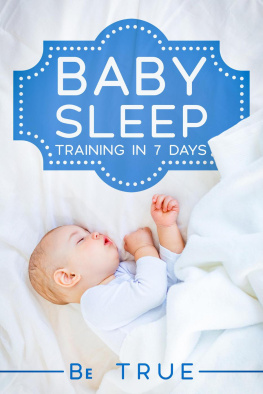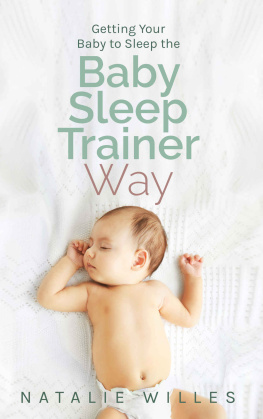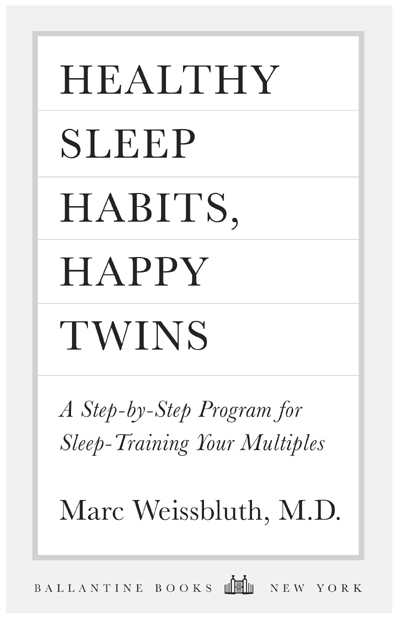ALSO BY MARC WEISSBLUTH, M.D.
Introduction
C ongratulations on your twins or multiples! Twins and multiples are more than double the fun: this is an exciting and magical time for your growing family.
Whether youre still expecting and are reading this book to prepare for life with your new babies or have already brought the babies home from the hospital and are starting to feel the effects of sleep deprivation, I hope this book will help you enjoy your babies more and be less anxious about their needs. Read front to back or in fits and starts, this book will give you the information you need to help your children begin to fall asleep on their own, stay asleep, and sleep regularly. Which means that in a short time, the whole familyMom and Dad includedwill be more rested and generally happier.
As founder of the original Sleep Disorders Center at Childrens Memorial Hospital in Chicago, I have studied both healthy and disturbed sleep in thousands of children. I have also been a pediatrician for more than thirty-five years and am the father of four children (and six grandchildren, at this writing). It is this combined experience that helped me develop the method I call sleep training, a process for instituting a daily routine and teaching infants to soothe themselves. My first book, Healthy Sleep Habits, Happy Child, details the sleep-training technique for children of all ages and, Im proud to say, has helped almost a million families get a better nights sleep.
More recently, I conducted an interesting research project with the parents of twins whom I met through my practice or in twin support groups that Ive conducted through the years. I had more than a hundred sets of parents fill out an extensive survey so that I could better understand their experience with sleep-training their twins, their concerns, and their questions. I heard countless stories of how getting twins to sleep well and sleep on a schedule was clearly worth the effort. Mothers who were getting more sleep themselves reported less baby blues and postpartum depression. Mothers also told me that getting their babies to sleep well made them generally less anxious about taking care of their twins: feedings got easier, and everyones mood was improved. Fathers also reported much less tensionin their wives, in themselves, and in their marriages. The answers and comments these parents provided has largely guided the information I will share in this book.
Sleep-training twins presents special challenges. The fundamental issue is obviously that there is not enough of you to go around most of the time! With one baby, mothers and fathers (and their help, if they choose to get it) can take turns feeding and caring for that baby during the day and during the night so that, in theory at least, one of the parents is rested most of the time. With twins, either one parent is pulling double duty or both parents are sharing the load the best way they can work out. Either way, parents of twins often wish they could clone themselves so that they could both get more of a break from the seemingly endless rush to soothe, feed, change, orhappilyplay with the twins. Without this futuristic technology, this book offers special solutions for sleep-training your multiples. I offer help for bleary-eyed parentssleep and some semblance of a routine will return to your family soon!
Beyond giving me a better understanding of the unique challenges involved in getting twins and multiples to sleep, my recent research also revealed some interesting facts about sleep patterns in twins. Parents report that fraternal twins are harder to get to sleep because they are often fundamentally not on the same clock or schedule. Identical twins seem to be more in sync with each other from the very start, and many parents of identical twins find that they have an easier time getting the twins to be on the same sleep schedule.
My research also revealed some interesting results about the ways in which parental age and experience impact sleep-training twins. Some older parents reported feeling that their age was an advantage because they felt it gave them the benefit of more confidence, patience, and tolerance for the crying that sometimes accompanies sleep training. Other older parents felt that their age was a factor in their exhaustion and were therefore highly motivated to sleep-train their twins as soon as possible.
Whether or not Mom underwent assisted reproductive technology (ART) to conceive her twins also seems to indirectly impact the babies sleep. Some moms who underwent protracted ART efforts reported having very little motivation to impose schedules or sleep training on their twins; instead, they wanted to spend as much waking time as possible with their twins and wanted to soothe their children to sleep at the breast or by holding and rocking them instead of teaching them self-soothing techniques. Mothers in my survey who reported experiencing baby blues or postpartum depression had a harder time sleep-training their twins, likely because they were having an all-around harder time with the transition to motherhood. That said, sleep trainingand the rest for everyone that comes with itturned out to be one of the things that greatly helped lift their depression. Chapter 7 outlines and summarizes my survey findings so that you can anticipate and prepare for the possibility of having a similar experience.
Even knowing these trends, however, whats important to take away from the results of my study is that sleep training can work and work wellquicklyfor twins, whether fraternal or identical, conceived using ART or otherwise! Indeed, the process of falling asleep is learned behavior. I will do my best to make sure that you find a comfortable way to teach your twins how to become great sleepers.
A word about how to use this book: Part I gives you the fundamentals of sleepwhy we all need it and what healthy sleep comprises. Many people say, Whats not to understand? I need sleep, my babies need sleep, tell me how to get it!, and I certainly understand the impulse to skip this descriptive section and get on with the business of learning to sleep-train your children. But I hope that even if you skip ahead to Sleep Strategies for Twins and Multiples (Part II ) or Troubleshooting (Part III ), you will eventually circle back and read Part I as well. I cant underscore enough the importance of understanding sleep fundamentals. With a greater appreciation of what goes into good or healthy sleep, you may become more motivated to provide it for your children.
Last but not least, I want to point out that throughout this book you will periodically find the comments of parents of multiples that I have worked with or studied. I hope you will find some comfort in hearing about their experiences. I find that in just sharing their frustrations and their successes, new parents can teach one another so much.











